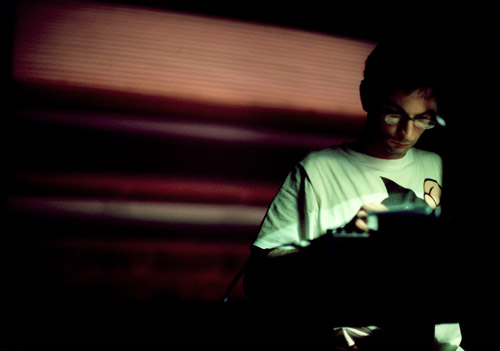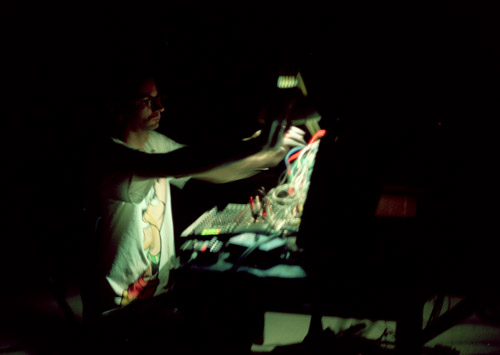-
16Sep2001
- share:
-
2001 US Engine tour
In its original version, Engine utilizes two guitars and a bass, a stereo amp and speakers (for feedback with the guitars), motors on the strings, a mixer, an analog modular system and a host of effects.
Engine
2001 US tourThis tour included a US premiere performance of a piece called Engine. In its original version, Engine utilizes two guitars and a bass, a stereo amp and speakers (for feedback with the guitars), motors on the strings, a mixer, an analog modular system and a host of effects.
I prepared a "portable" version of the piece, with electronic feedback instead of electro-acoustic, using only the modular system and mixer, with the motor sounds on minidisc. The majority of the sounds is generated by empty circuits oscillating on their own and modulated by the modular's devices. It's played on two independent circuits, akin to playing two versions of the piece simultaneously, one in the left channel and the other on the right.
JULY
7 NYC Tonic
8 Rochester, NY Visual Studies Workshop
10 Toronto, Canada, The NOW Lounge
14 Chicago, IL 6Odum
15 Roxbury, MA Berwick Research Insititute
16 Easthampton, MA Flywheel

ChicagoThere is no tour diary for this one, just this tour info…
The Toronto gig was known for at some point into the set, during a really loud passage, the framed pictures hung on the wall started to fall with the vibration, shattering glass all over the floor…Interview excerpts on Engine
Would you describe the concept and process/working methods behind the piece you played on your recent U.S. tour, "Engine"?
"Engine" is a piece based on modulated feedback, in a process that undergoes several changes and is performed on twin circuits, that is, i play two simultaneous versions, one on the left channel and one on the right, resulting in a complex and dynamic long drone. In its original version, it takes a car full of gear, including two guitars, a bass, a stereo amp and speakers (for feedback with guitars), an analog modular system, electric motors (to drive the guitar strings), a collection of pedals and a mixer. I decided to prepare a much simpler and portable version, just using electronic feedback between the mixer and the modular system and with the motor sounds recorded on minidisc. Electronic feedback is a much harder and harsher sound than acoustic feedback, there's a lot of violence in it. I was convinced i could make it sound smoother, but when i started the tour i realised the piece had taken its own direction. It had become less interesting as a drone and was quite more violent. I decided make the handling of that into a fun process and go with the flow. It worked well on the performance aspect. If people pay to see me play, i feel obliged to offer an experience with chances to be in some way rewarding to the listener
(Grooves, 2001)
I’ll play, for the first time in the US, a recent piece called "Engine". It’s basically a modulated feedback piece. In its original version, it takes a 13 feet wide table full of stuff, including two guitars and a bass, a stereo amp and speakers (for feedback with the guitars), motors on the strings, most of the pedals I have, a mixer and an analog modular system. I prepared a "portable" version of it, with electronic feedback instead of electro-acoustic (no guitars, then), using only the modular system and the mixer, with the motor sounds on MiniDisc. So most of the sounds will be made by empty circuits oscillating on their own and modulated by the modular’s devices. It’s played on two independent circuits, so it’s like playing two versions of the piece simultaneously, one in the left channel and the other on the right.
(City Newspaper, 2001)Share the love
Related
-
16Sep2001
- share:
Search
Upcoming Concerts
There are no dates yet.
About
Rafael Toral (Lisbon, 1967) has been exploring the connection between sound and music since he was a teenager. He pioneered blends of drone minimalism with rock as in Wave Field, the free-jazz inspired experimental electronics of the Space Program, and has recently synthesized all the above on guitar-based Spectral Evolution (Feb. 2024), his new major album.
©
2023 Rafael Toral. All Rights Reserved.






